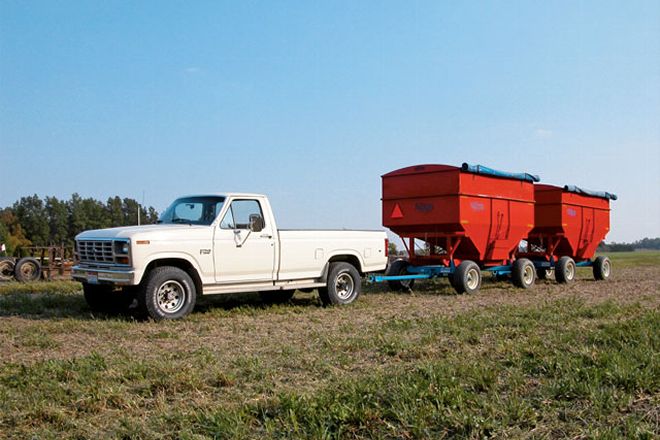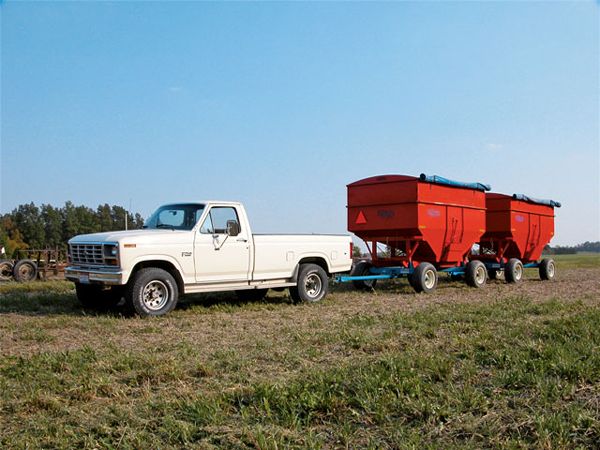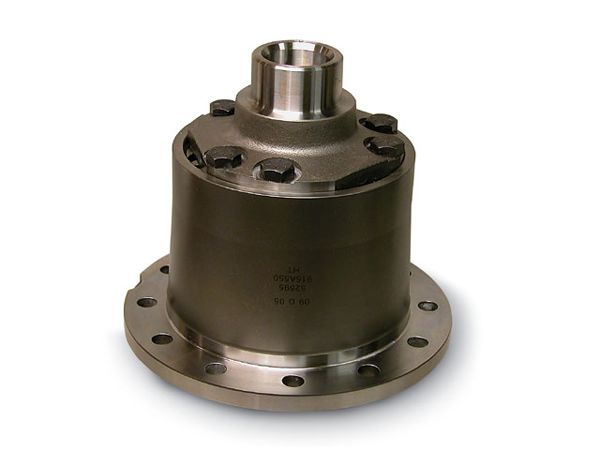
 Extreme towing! Here is our test mule pulling two grain trailers with about 200 bushels of wheat in each. At 60 pounds per bushel, that's about 24,000 pounds of wheat, plus the weight of each trailer (1,500 pounds) and the truck tipped the scales at 7,345 (6,345 and 1,000 pounds of tractor weights in the back). Grand total: 34,345 pounds! Here we tried to get it moving in two-wheel drive with an open diff in the soft dirt of the field. No go-one-wheel drive. Later, with the Truetrac installed, there was some spinning (from two tires this time) but the truck could get the load moving in two-wheel drive. Either way, without the extra weight in back, it was a no-go. The diesel truck is very nose-heavy and these types of wagons add no tongue weight.
Extreme towing! Here is our test mule pulling two grain trailers with about 200 bushels of wheat in each. At 60 pounds per bushel, that's about 24,000 pounds of wheat, plus the weight of each trailer (1,500 pounds) and the truck tipped the scales at 7,345 (6,345 and 1,000 pounds of tractor weights in the back). Grand total: 34,345 pounds! Here we tried to get it moving in two-wheel drive with an open diff in the soft dirt of the field. No go-one-wheel drive. Later, with the Truetrac installed, there was some spinning (from two tires this time) but the truck could get the load moving in two-wheel drive. Either way, without the extra weight in back, it was a no-go. The diesel truck is very nose-heavy and these types of wagons add no tongue weight.
Axle buildups are part and parcel on the tech side of Four Wheeler but we've never covered the particular needs of a truck that tows a lot. We decided to subject an old buddy to some tests and improvements in order to determine the needs of a towing axle and the cures to any problems.
Our test mule, an '86 F-250HD 4x4 with its Banks-turbocharged 6.9L diesel engine and C6 automatic, has never been anything other than a work truck. Its first 15 years were spent towing a variety of 25- to 30-foot fifth-wheel and tow behind camper trailers, as well as carrying a couple of different overhead campers. These days it's a farm truck, still hauling and towing a variety of equipment.
We started by talking with Carl Montoya at Randy's Ring & Pinion, to find out what special needs a towing axle has versus a 'wheeling axle. Carl runs Randy's retail repair/rebuild shop, where they do a huge amount of axle work as well as R&D for Randy's new products.
"It's all about heat," he said. "The most wasted axles we see here are in motorhomes, box vans, and pickups that tow."
An axle under load generates heat-sometimes well over 300 degrees oil temperature if you let it get that far. More load equals more heat, and that's almost always where failure starts. A trail axle may endure higher peak torque loads, but a towing axle endures a heavy load over a long period of time-from hours to thousands of miles at a time. A towing axle failure is typically related to lubricant failure from heat. When the oil fails, the hard parts follow rather quickly. Without boundary lubrication from the gear oil, massive amounts of friction across the surface of the gears can create temperatures high enough to melt the metal surfaces.
In order to find out what was going on in our test axle, we installed a diff temp gauge. You don't see these on many trucks, but they aren't hard to find. Auto Meter makes fine diff-temp gauge sets in a variety of styles and the means to install them in most any diff. For steel covers, they make a weld-in bung. We used both on our test rig to run the oil temperature tests. We designed an easily duplicated test course on the rural roads in the northwest Ohio wilderness. Some of it was solo, carrying only a 1,000-pound test load of tractor weights, and some was towing a grain wagon with five tons of gravel in it. We also had a chance to haul a pair of large grain wagons full of wheat.
We started by giving the bone-stock Sterling 10.25 full-floater a fresh fill of 85W-90 Valvoline mineral (petroleum)-based gear oil to get our baselines with an "average" off-the-shelf oil. We opted to stay within the 90-weight realm rather than moving up to a 140w. The experts we consulted told us that a sustained 200 degrees (or more) was the best indicator to use a 140-weight oil. Oils lose viscosity with heat and at higher temperatures, and a 140-weight will retain the boundary lubrication needed to protect the gears where a 90-weight might not. The downside is that the heavier oil creates more parasitical drag (costing mpg) and creates more fluid friction at lower temps.
Figuring we couldn't test every type of gear oil on the face of the globe, we looked for two benchmarks from both the synthetic and the mineral realms to use as upgrades and found Amsoil and Lubrication Engineers (LE).
Amsoil is a well known supplier of quality synthetic lubricants. We obtained enough of their Series 2000 75W-90 for a couple of oil changes. We were partly through the tests when we discovered that the Series 2000 oil has been replaced by a new formulation called "Severe Gear." The Severe Gear may be better, but the Series 2000 did plenty good, reducing the solo temps by 15 degrees and the towing temps by 25. The synthetic base oil, combined with Amsoil's additives, were responsible for the drops in temp.
LE is lesser known to the 'wheeling public but a force in the commercial and specialty formulations market. The LE607 Almasol straight 90-weight mineral-based oil has been making a name for itself in the racing and high-performance markets along with the company's "bread and butter" commercial realm. This is a sleeper oil that four-wheelers should be looking at if they don't run in temps below about zero degrees Fahrenheit. It dropped our solo temps by 20 degrees and towing by 30. This oil relies heavily on its additive package, the foundation of which is Almasol, a proprietary wear- and friction-reducing element.
This is probably the most important element in building a towing axle. Even an average oil can survive long towing work if it stays cool. The universal magic number is 225 degrees. At that temp, oxidation is occurring in a major way. Some sources show that the rate of oxidation increases dramatically at oil temps above 140, and increases by 100 percent for every 50 degrees above that. The byproducts of oxidation are acids that will corrode and pit metal parts. The most common type of EP (Extreme Pressure) additive package, sulfur/phosphorus (S/P), begins to break down at temperatures above 200 degrees as well, leaving your hard parts less protected from wear. They also convert into acidic components that can eat into parts.
One of the best ways to keep an axle cool is by increasing oil capacity. The Mag-Hytec cover chosen for our Ford 10.25 test mule increased the capacity of our axle by 3 quarts. Not only does this cover have more surface area with which to radiate heat (plus cooling fins), the increased capacity gives the oil more "dwell" time in which to cool off. In our case, the Mag-Hytec knocked an honest 25 degrees off the oil temp with no other changes. When combined with the LE607, a total of 55 degrees was taken off the oil temperature, and 50 degrees with the Amsoil in the same conditions.
What it boils down to is that any increase in capacity or any improved means to radiate heat is useful. By the way, overfilling the housing doesn't count. Oil levels that are too high actually make the axle run hotter due to fluid friction and aeration. The higher-capacity covers increase capacity while keeping the actual level the same, or close to it.
A traction aid in the form of a locker or limited-slip is as useful to a tow rig as to any 'wheeler, even when towing. We chose to incorporate the new Detroit Truetrac for the Ford Sterling in our buildup. It proved to be virtually seamless, whether towing or solo. It got us off a field of soft dirt in two-wheel drive while towing a pair of loaded grain trailers weighing over 30,000 pounds. The open diff couldn't in the same situation, and just spun a tire. The ice and snow performance was outstanding, because the gear-drive Truetrac doesn't rely on traction to release the clutches in a turn like a plate-type limited-slip. The truck rolls around a corner as smooth as glass but has a higher bias ratio than most other limited-slips for improved traction on soft ground.

We got to try out the new Truetrac application for the Ford 10.25 and 10.50 axles. It's a pretty hefty unit, about 10 pounds heavier than the stock open carrier. If your Ford is quipped with the optional Trac-Lok limited-slip, don't cry to see it go away. It has such a low bias ratio as to be nearly ineffective. The Truetrac has a bias ratio of about 3.5:1. (On its best day, the OE unit was under 2:1.) The best part is that the Truetrac is seamless on the street, despite its good bias ratio, because it uses gears instead of clutches.
To recap what we learned from this, any towing axle should start with a diff-temp gauge and go from there as needed. A high-quality gear oil with friction modifiers and/or a high-capacity cover are the next steps. Limited-slips and lockers don't seem to add much heat, but they will prevent a tow rig from being stuck in a rest area parking lot-which our test rig once experienced.
We learned that hard parts are seldom necessary for an axle used within the truck's Gross Combined Vehicle Weight Rating (GCWR), or even a few steps beyond. You simply don't get the sorts of torque spikes when towing that kill so many axle parts on the trail. Bigger tires may dictate some upgrades, or a machine that tows hard and 'wheels. In our case, the truck runs tires that are only about 15 percent taller than stock, and it has plenty of reserve strength.
We used an '86 Ford F-250HD 4x4 diesel as a test mule. It has 4.10:1 gears and uses the legendary Sterling 10.25 full-floating rear axle. We installed a diff-oil temp gauge and ran the truck under varying conditions with three different lubricants and in a couple of different configurations. The testing was done in northern Ohio, where steep hills are in short supply, so we substituted heavy loads over a measured course driven at the same speeds and with the same number of starts and stops each time.
Three courses were used: Course A, a 45-mile loop of mixed rural roads at 50 to 60 mph and freeway at 70 mph with a total weight of 7,345 pounds; Course B, a 25-mile loop at 40 mph over rural roads, with many stops and starts and a total weight of 18,625 pounds (7,345 truck, 10,180 gravel and 1,100 trailer); and Course C, a one-time event with two loaded grain trailers, with very soft tires-a 5-mile loop at 20 mph with a total weight of 34,345 (whew!).We also pulled the grain trailers across a plowed field to test the Truetrac.
Our tests did not generate the massively high temps a truck towing 10,000 pounds over the Rocky Mountains might generate, but it did show us how the axle reacted to various situations and products. In monitoring temps, we noted that speed plays a part. At low speeds, temps were always lower than at higher speeds. When we slowed down to 25 mph, even with our test load, temps dropped dramatically. Repeated accelerations from a dead stop dramatically added temperature.
Situation (1) Modification Temp(deg.) Solo, Course A None 170 Tow, Course B None 195 Tow, Course C None 285 Solo, Course A Mag-Hytec 145 Tow, Course B Mag-Hytec 185 Solo, Course A Amsoil 75W-90 155 Tow, Course B Amsoil 75W-90 170 Solo, Course A Amsoil + Mag-Hytec 125 Tow, Course B Amsoil + Mag-Hytec 145 Solo, Course A LE607 SAE 90 145 Tow, Course B LE607 SAE 90 165 Solo, Course A LE607 + Mag-Hytec 125 Tow, Course B LE607 + Mag-Hytec 140 *All tests done at 60-65 degrees ambient








